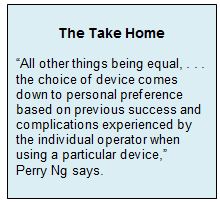Key Points:
- Researchers use MR CLEAN data to compare outcomes of mechanical thrombectomy based on device used
- Efficacy and safety largely similar across devices
Interventionalists should be free to choose their preferred mechanical thrombectomy device, whether Solitare or Trevo, when treating patients with acute ischemic stroke, according to a fresh analysis of data from the MR CLEAN trial.
The study, which looked for differences in efficacy and safety by device type, was published online September 6, 2016, in Stroke.
In the Netherlands, the chief of radiology selects thrombectomy devices based primarily on price and the preferences of the radiology team, lead author Diederik W. Dippel, MD, PhD, from Erasmus MC University Medical Center (Rotterdam, the Netherlands), told Neurovascular Exchange in an email.
Dr. Dippel said he and his colleagues determined that the outcomes associated with each available device should be evaluated formally when some device manufacturers suggested that outcomes of mechanical thrombectomy in the MR CLEAN trial, originally published in January 2015 in the New England Journal of Medicine, were slightly lower than those seen in later trials because of device selection. “We are of the opinion that our results, which favored thrombectomy anyway, were mostly determined by our minimal selection criteria, allowing patients with a poor prognosis in the trial as well,” he explained.
For the new analysis, the investigators examined data on the 233 of the 500 participants in the MR CLEAN trial who were allocated to an intervention. Of these, 124 (53%) were first treated with Trevo (Stryker Neurovascular), 31 (13%) with Solitaire (Covidien), and 40 (17%) with other retrievable stents or mechanical devices. Another 38 (16%) could not be treated with mechanical thrombectomy.
“Device choice did not seem to depend on patient characteristics, but [rather] on local availability,” said Dr. Dippel. “That removes some bias of this inherently observational substudy.”
There was no interaction between device and treatment effect on infarct volume or on functional outcomes, including mRS, Barthel index, or changes in NIHSS score. The one difference related to persistence of occlusion on CTA, which was common with Trevo and Solitaire versus with other devices (table 1).
Safety outcomes were also largely similar for patients treated with the different devices. Rates of symptomatic intracerebral hemorrhage did not vary significantly by device type or in comparison with controls. There were no statistically significant differences in the occurrence of parenchymal hematoma types 1 and 2 or of new infarcts occuring in a different territory among patients treated with the different devices.
Rates of death within 7 days and 3 months were higher among those treated with other devices (27.5% and 40%) than those treated with the Trevo (9.7% and 15.3%) or Solitaire (16.1% and 22.6%), however.
Timing and work flow were similar for all groups of patients who underwent mechanical thrombectomy. Time to successful reperfusion, defined as TICI 2b/3, was similar for all 3 groups, as was the median number of attempts.
Second Generation an Improvement Over First
Perry Ng, MD, of Centura Health Physician Group (Denver, CO), told Neurovascular Exchange in an email that the two major stent retrievers—Solitaire and Trevo—are extremely similar in terms of technique, deliverability and pricing.“In my own experience,” he said, “I have not found Solitaire to be superior to Trevo or vice versa, which is borne out in [this study].”
On the other hand, “first-generation devices like the MERCI have been shown to be less effective at achieving good recanalization (TICI 2b/3) compared with current generation devices,” he said. This may help explain why patients treated with the “other” category of devices in this study had a trend toward poorer clinical outcomes.
“All other things being equal,” said Dr. Ng, “I think the choice of device comes down to personal preference based on previous success and complications experienced by the individual operator when using a particular device.”
Both Dr. Dippel and Dr. Ng noted that intracranial aspiration catheters are being increasingly used either in combination with or instead of stent retrievers. These were rarely used in MR CLEAN, so the outcomes of these different approaches could not be compared using its data.
Source:
Dippel DW, Majoie CB, Roos YB, et al. Influence of device choice on the effect of intra-arterial treatment for acute ischemic stroke in MR CLEAN (Multicenter Randomized Clinical Trial of Endovascular Treatment for Acute Ischemic Stroke in the Netherlands). Stroke. 2016;Epub ahead of print.
Disclosures:
- Erasmus MC received funds from Stryker and Bracco Imaging for consultations by Dr. Dippel.
- Dr. Ng reports no relevant conflicts of interest.



